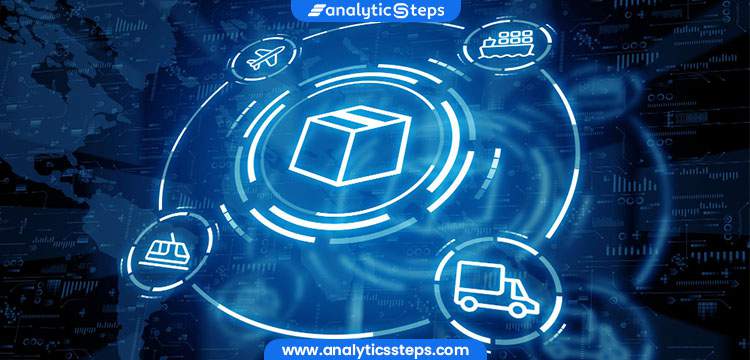
Blockchain, the digital record-keeping technology that powers Bitcoin and other cryptocurrency networks, has the potential to change the financial landscape. However, supply chain management is another area where it shows great promise. Blockchain has the potential to significantly improve supply chains by enabling faster and more cost-effective product delivery, improving product traceability, improving partner coordination, and facilitating access to financing.
Due to the numerous intermediaries involved in the process of taking a product from its source to a merchant, today's supply chain process is very complex, opaque, costly, and inefficient. The lack of collaborative systems among all of the intermediary parties involved makes this process even more opaque and difficult to track. The traceability of an item is almost completely lost by the time it reaches the end user. The end-user has no idea where the item came from and can only trace it back to its last source.
What is Supply Chain Transparency?
When a company knows the full extent of its supply chain and communicates it internally and externally, it is said to have supply chain transparency. For complete transparency, they must include every stage of the supply chain, from raw material harvesting and transportation to finished products and services delivered to customers.
A company should be able to easily communicate information about each of its suppliers (including direct and indirect suppliers). The inherent risks to human and environmental rights associated with each supplier's countries, industries, and activities should be included in this information Supply chain transparency was virtually unknown 15 years ago, but it now commands the attention of mid- and senior-level executives across a wide range of companies and industries.
The reasons for this increased interest are obvious: companies are being pressed by governments, consumers, NGOs, and other stakeholders to reveal more information about their supply chains, and the reputational cost of failing to meet these demands can be severe. Food companies, for example, are seeing an increase in demand for supply-chain-related information about ingredients, food fraud, animal welfare, and child labor.
Less clear is how to define transparency in a supply chain context and how far companies should go to achieve it: an MIT study that mapped supply chain transparency definitions related to labor practices in the apparel industry found vastly differing definitions across organizations. Companies must be aware of what is happening upstream in the supply chain and communicate this knowledge both internally and externally.
One reason for the process's growing importance is that more consumers are demanding it. For example, MIT Sloan School of Management researchers discovered that consumers may be willing to pay 2% to 10% more for products from companies that provide greater supply chain transparency. Consumers valued information about the treatment of workers in the product supply chain and the seller's efforts to improve working conditions in this study. This growing segment of discerning consumers seeks information on product ingredients and materials, where products come from, and the conditions under which they were produced across industries.
As these demands have grown, so has the reputational risk for businesses from media and non-governmental organization campaigns. Numerous scandals have significantly harmed corporate reputations over the last decade. The Rana Plaza factory collapse in the fast fashion industry, slave labor in the Thai seafood industry, and deforestation in Malaysia and Indonesia are all notable examples.
Why is Supply Chain Transparency Important?
Growing consumer demand has increased the importance of supply chain transparency, particularly for everyday consumer goods such as food and clothing. Consumers are concerned about the ingredients in their food, the origins of their clothing, and the manufacturing processes of the products they purchase. They are also concerned with the ethical and environmental sustainability of the companies they support.
Emerging issues such as climate change, as well as tragic events such as the Rana Plaza garment factory collapse, have increased consumer awareness and concern about ethical and sustainable sourcing. The most obvious advantage is that it allows you to comply with increasingly stringent regulations. Transparent supply chains also reduce reputational risk and strengthen the company's reputation as a reliable business.
A third advantage is attracting and retaining employees who want to work for ethical companies. Patagonia and Nike have very high job application rates as well as very low employee turnover, which is due in part to their reputations as responsible companies. Patagonia claims an annual employee turnover rate of less than 4%. A fourth advantage is increased consumer trust and satisfaction, which Ryan Buell discusses in his recent HBR article on operational transparency.
Consumers are not the only ones demanding greater transparency from businesses. Investors are also more supportive of companies that practice transparent, socially, and environmentally sustainable business practices. Many studies on businesses that invest in ESG and sustainable practices (for example, the Morning Star ESG index) have found that these businesses outperform those that do not. These companies have a lower compliance burden, a more resilient supply chain, and better brand reputations. As a result, organizations that manage supply chain risk through robust ESG initiatives pose less of a financial risk to investors and are more valuable.
Benefits of Blockchain in Supply Chain Transparency
The blockchain's core technology is the decentralized ledger, which records and protects transaction data shared by multiple parties. The blockchain is used by cryptocurrencies such as Bitcoin, Ethereum, and Dogecoin to theoretically allow infinite and anonymous parties to conduct transactions without the need for an intermediary.
However, in supply chain management, the emphasis is on allowing a limited number of known parties to conduct direct transactions with one another while improving security, ensuring contract compliance, and lowering costs. Supply chain blockchains "tokenize" a variety of transaction-related data instead of coins, creating unique and easily verifiable identifiers for purchase orders, inventory units, bills of lading, and so on.
Blockchain for supply chain logistics can enable trusted and secure digital information sharing across a complex network. Here are ways blockchain in logistics can assist suppliers, manufacturers, distributors, and retailers in meeting consumer demand for faster, more convenient delivery of a wider range of goods.
Benefits of Blockchain in Supply Chain Transparency
-
Verify provenance throughout the supply chain:
According to Greg Carter, CTO of GlobalTranz, a transportation and logistics provider based in Scottsdale, Ariz., additional scrutiny of high-value assets and high-value goods is required as they move through the supply chain. When it comes to handling high-value goods, blockchain provides validation that there has been no disruption or corruption of the data. The same is true for perishable goods and pharmaceuticals. If we can use a blockchain to prove the provenance at any of the touchpoints along the way, especially a standards-based blockchain, it gives us even more confidence.
-
Improved efficiency:
Improved Efficiency because Increased traceability and transparency reduce waste, duplicate orders, and accounts payable headaches like invoice fraud and rogue spending. Contract compliance contingencies encourage all parties to fulfill their agreed-upon obligations on time, in full, and accurately. By reducing uncertainty and risk, full visibility of financial information and performance improves financing options for small businesses and reduces processing times.
-
Make transparency a priority:
According to Andy Stinnes, a venture partner at Cloud Apps Capital Partners in San Francisco, the most significant advantage of using blockchain in supply chain logistics is transparency. Transportation logistics is one area of the supply chain where the complexity of dealing with and coordinating across many partners is most visible. According to Stinnes, the value proposition for blockchain in supply chain logistics is the ease of information exchange. According to Stinnes, it is difficult to obtain an accessible and consistent view of data. Blockchain is intended to address this issue. "This is why everyone is so enthusiastic about blockchain in the supply chain in general, and transportation logistics in particular."
-
Greater savings:
With blockchain technology, efficiency gains and reductions in stock loss and waste are significant sources of cost savings. A distributed network that digitally shares resources and transactions eliminates the need for paper-based workflows and materials. Going paperless not only saves money on materials but also saves money on storage and the labor required to process and manage all those physical documents.
-
Provide quality assurance:
Using blockchain in supply chain logistics allows all authorized participants in a transaction to access critical data to validate the transaction's milestones. "For example, you have a repair depot where you get spare parts and do repairs on some critical device," Stinnes explained. "You can ensure that the repair has been validated and tested, and you can include the test results at the repair facility in a public blockchain or a supplier blockchain." According to him, blockchain should be used to prove test results, the provenance of parts, and possibly even the certification of the technician performing the repair.
-
More ethical and long-term sourcing:
The blockchain's traceability and tamper-resistance make it easier to verify where materials and goods originate, where they go as they travel through the supply chain, and who has access to them.
Real-World Supply Chain Applications
Some of the real word supply chain applications of supply chain applications:
-
Stratis:
Stratis, a platform based in the United Kingdom that primarily focuses on leveraging Microsoft technologies, is now collaborating with programmers all over the world to provide an ultimate solution for supply chain management, powered by complete visibility in a trustless, highly secure decentralized environment. This means that programmers all over the world will be actively developing and committed to delivering diverse solutions, demonstrating the power of the Stratis platform, and assisting in building with Stratis Blockchain Technologies.
-
Treum:
Treum is a blockchain-based supply chain operating system that prioritizes traceability, transparency, and the ability to trade. It enables enterprises to build customer trust by seamlessly recording end-to-end information on assets, allowing manufacturers to verify if their supply chain is meeting their product goals.
-
Tony's Chocolaty:
Millions of tonnes of cocoa beans are produced annually in many parts of Africa by child laborers and slaves; however, Tony's Chocolonely, an Amsterdam-based chocolate company, has taken a step forward in helping to end child labor and modern slavery. They are developing a shared value chain platform known as a bear tracker, which includes a monitoring tool that can track the location of the bean at any time and from any location. The bean tracker connects all farmer coops and supply chain actors, and data is entered weekly.
-
Luxarity:
Luxarity has partnered with major blockchain development companies to provide complete transparency of the donation cycle through the use of blockchain technologies. They intend to create a user-friendly donation tracing solution that will integrate seamlessly with their existing customer journey and encourage consumer participation without causing any inconvenience. It focuses on creating an immutable record of how contributions are allocated, allowing consumers to choose which social and educational causes to support.
Conclusion
In Conclusion, The rise of blockchain occurred when people desired to decentralize applications and operations and make reliance on centralized third-party entities such as banks optional rather than mandatory. This distributed ledger technology is being used by industries to solve long-standing business problems. Supply chain management is gradually gaining traction in the global market, but it faces several challenges. The article has shed some light on how to remove the majority of these roadblocks using blockchain.

